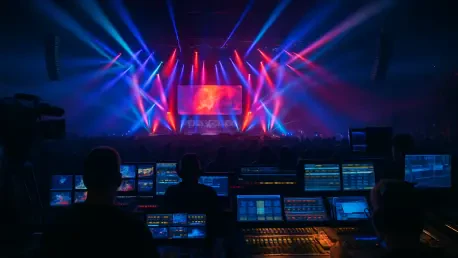In an era where live events have become cornerstones of entertainment and connection, technology stands as the driving force behind their evolution, reshaping every facet of these experiences from sprawling music festivals drawing tens of thousands to high-stakes sports championships captivating global audiences. No longer a mere accessory, event technology has emerged as the foundation that ensures seamless operations, heightened engagement, and uncompromising safety. As attendees increasingly demand immersive and personalized interactions, organizers are turning to innovative solutions to meet these expectations. This exploration delves into the profound ways technology is revolutionizing live events, addressing operational challenges, enhancing audience connections, bolstering security, unlocking financial potential, and paving the way for sustained growth in a dynamic industry.
Streamlining the Backbone of Event Operations
The orchestration of major live events involves juggling countless moving parts, and technology serves as the linchpin that holds it all together. Unified data platforms integrate critical elements such as ticketing systems, audiovisual setups, and communication networks into a single, manageable ecosystem. This connectivity empowers organizers to oversee operations with precision, ensuring that every component functions in harmony. Real-time insights derived from these systems allow for immediate adjustments, whether it’s addressing a sudden spike in attendance or reallocating resources to prevent bottlenecks. For events hosting thousands, this level of efficiency is not just beneficial but essential, as it minimizes disruptions and keeps schedules on track. The result is a smoother experience for both staff and attendees, where logistical hiccups are addressed before they escalate into larger issues, setting a new standard for operational excellence in the events space.
Beyond integration, event technology transforms how challenges are tackled during the heat of an event. Dynamic monitoring tools provide a live snapshot of venue capacity, queue lengths, and resource distribution, enabling swift decision-making. Imagine a scenario where a sudden influx of attendees threatens to overwhelm entry points—technology steps in to redirect staff or open additional gates, averting chaos. This adaptability extends to behind-the-scenes coordination, where communication systems ensure that teams remain aligned despite the fast-paced environment. By reducing downtime and enhancing responsiveness, these tools allow organizers to maintain control over sprawling events, ensuring that even the most complex productions unfold without a hitch. This operational agility not only improves the immediate event flow but also builds confidence among stakeholders that future endeavors can scale effectively.
Crafting Unforgettable Audience Connections
Modern event attendees arrive with expectations of more than just a spectacle; they seek experiences that feel tailored and interactive. Event technology rises to this challenge by offering digital touchpoints such as mobile app updates, personalized content, and interactive displays that immerse participants in the moment. These tools create a bridge between the event and the individual, fostering a sense of involvement that static formats cannot match. Whether it’s receiving real-time notifications about a schedule change or engaging with live polls during a performance, attendees feel connected at every turn. This shift toward personalization ensures that each person walks away with a unique memory, amplifying the event’s impact and encouraging social sharing that extends its reach far beyond the venue walls.
Taking engagement a step further, data analytics play a pivotal role in fine-tuning the attendee journey as it unfolds. By tracking movements and identifying moments of peak interaction, organizers gain actionable insights into what resonates most with their audience. This might mean adjusting the timing of a key performance to maintain energy levels or redirecting crowds to underutilized areas to balance flow. Such real-time adaptability transforms a good event into a great one, as adjustments are made with precision to maximize satisfaction. Additionally, the data collected offers a roadmap for future events, highlighting successful elements to replicate and areas needing improvement. This continuous feedback loop ensures that engagement strategies evolve with audience preferences, cementing loyalty and driving repeat attendance in an increasingly competitive landscape.
Fortifying Safety in Crowded Spaces
Ensuring the safety of attendees remains a paramount concern at any live event, and technology provides robust solutions to address this critical need. Advanced surveillance systems, real-time crowd monitoring, and predictive analytics work in tandem to spot potential risks before they become emergencies. These tools offer organizers a comprehensive view of the venue, identifying patterns such as overcrowding or unusual behavior that could signal trouble. By anticipating issues rather than merely reacting to them, event staff can implement preventive measures, such as adjusting entry and exit points or deploying additional security to high-traffic zones. This proactive approach is particularly vital in large-scale settings like stadiums, where the sheer volume of people demands meticulous oversight to maintain order and protect everyone present.
Moreover, crowd intelligence platforms enhance safety by delivering granular insights into attendee dynamics. These systems analyze data to pinpoint areas of congestion, enabling organizers to redistribute resources or alter layouts to alleviate pressure points. For instance, if a particular concourse becomes overly crowded during a halftime break at a sports event, staff can be redirected to guide attendees to alternative routes. This not only prevents potential hazards but also improves the overall experience by reducing frustration. The integration of such technology ensures that safety measures are tailored to the specific needs of each event, balancing security with accessibility. As a result, attendees can focus on enjoying the moment, confident that their well-being is prioritized through cutting-edge innovations that operate seamlessly behind the scenes.
Driving Financial Growth Through Innovation
Sustainability in the events industry hinges on financial viability, and technology opens up innovative avenues for revenue generation that align with attendee expectations. Cashless payment systems streamline transactions, cutting down wait times at food stalls or merchandise booths and encouraging more spontaneous purchases. Simultaneously, live sales data provides organizers with a clear picture of which products or services are in high demand, allowing for strategic adjustments like restocking popular items or reallocating staff to busy areas. This data-driven approach ensures that commercial opportunities are maximized without disrupting the event’s flow, creating a win-win for both organizers and participants who benefit from faster, more efficient service.
In addition to transactional efficiency, digital sponsorship activations represent a powerful revenue stream that technology makes possible. Brands can engage directly with audiences through interactive campaigns or targeted promotions displayed on digital screens or mobile platforms during the event. This direct connection not only boosts sponsor visibility but also generates income for organizers while adding value to the attendee experience. By analyzing behavioral and purchasing trends, event planners can tailor these commercial strategies to align with audience preferences, ensuring that monetization efforts feel organic rather than intrusive. This balance is crucial, as it preserves the event’s integrity while capitalizing on financial opportunities, positioning organizers to reinvest in future innovations that further elevate the live experience.
Laying the Groundwork for Future Triumphs
Event technology transcends immediate solutions by establishing a framework for long-term success in an ever-shifting industry. Post-event data analysis offers a treasure trove of insights, from attendance patterns to operational hiccups, providing a clear picture of what worked and what didn’t. Organizers can dissect customer journeys to understand key touchpoints, using this knowledge to refine logistics or enhance engagement strategies for the next gathering. Each event becomes a stepping stone, with lessons learned informing future planning to address pain points and capitalize on successes. This iterative process transforms isolated occasions into scalable models, ensuring that events remain agile and relevant amid changing audience demands and market conditions.
Furthermore, the ability to adapt based on comprehensive feedback positions events to thrive over time. Technology enables organizers to anticipate shifts in attendee behavior or industry trends, allowing for proactive adjustments rather than reactive fixes. For example, identifying a growing preference for hybrid formats through data trends can prompt the integration of virtual components in upcoming events, broadening accessibility and appeal. This forward-thinking mindset, supported by robust technological infrastructure, ensures that events don’t just keep pace but set the standard for innovation. By fostering a cycle of continuous improvement, technology empowers organizers to build resilient frameworks that withstand challenges and deliver consistent value to all stakeholders involved.
Navigating the Expansion of a Thriving Market
The global events industry is on a remarkable growth trajectory, with projections estimating a rise from $1,550.97 billion in the previous year to nearly $5 trillion by 2033. This expansion, fueled by demand for diverse formats including in-person, hybrid, and virtual events, underscores the urgent need for scalable solutions. Technology stands as the cornerstone of this evolution, equipping organizers to handle the increasing complexity and volume of modern gatherings. Integrated systems and data-driven tools enable the seamless execution of events across various platforms, ensuring that quality remains uncompromised regardless of format. This capability is crucial for staying competitive in a crowded market where attendees and sponsors alike expect flawless experiences tailored to their preferences.
Reflecting on the strides made, it’s evident that technology has fundamentally reshaped the landscape of live events over recent years. The adoption of sophisticated tools has addressed operational inefficiencies, elevated safety protocols, and deepened audience connections in ways previously unimaginable. Looking ahead, the focus must shift to harnessing these advancements for even greater impact—exploring emerging technologies like artificial intelligence for predictive planning or augmented reality for immersive engagement. Organizers are encouraged to invest in scalable platforms that adapt to future needs, ensuring events remain at the forefront of innovation. By prioritizing strategic integration of tech solutions, the industry can continue to deliver transformative experiences that resonate with audiences and sustain growth in the years to come.









